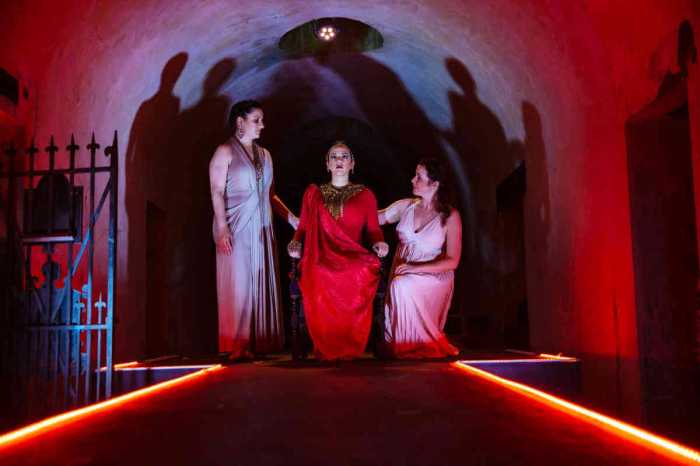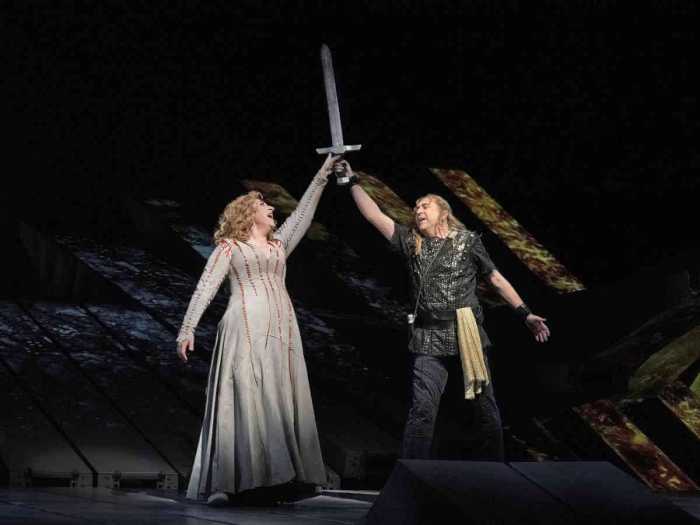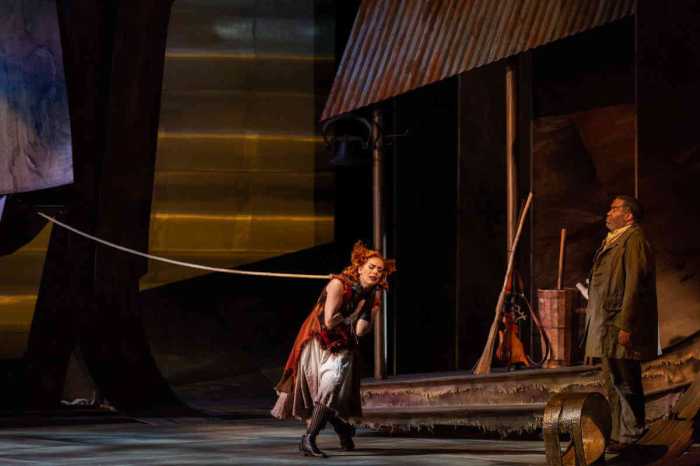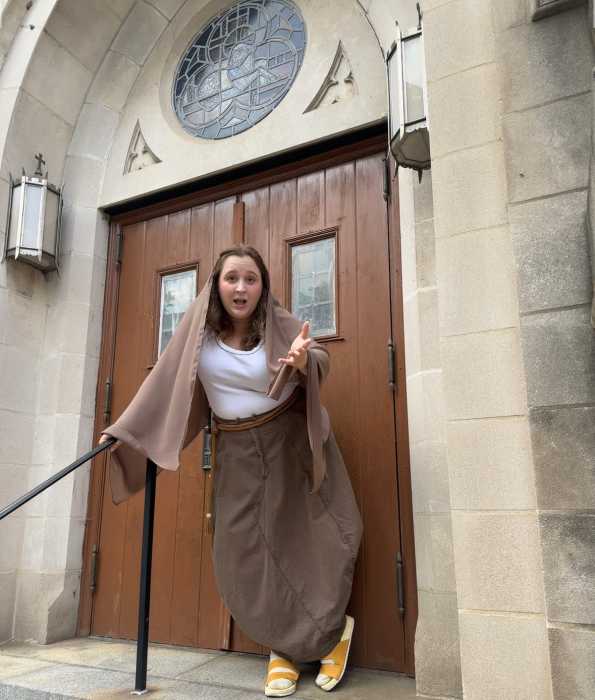BY ELI JACOBSON | In the world of opera, Richard Strauss’ “Elektra” (1909) defines the concept of “larger than life. Except for its tidy 100-minute length, this opera is big. It has the opera repertory’s biggest, loudest post-Wagnerian orchestration and requires the biggest, most powerful voices. The libretto by Hugo von Hofmannsthal (adapted from the Sophocles tragedy) embodies the life or death emotional intensity of Greek tragedy spiked with early 20th century Austro-German psychology. There are elements of Grand-Guignol melodrama, though all the bloodshed happens offstage.
The performance history of this opera has favored the grand and over-the-top: heavy metal volume emerging from the pit and the stage, expressionist movements, grotesque makeup, and silent movie grimaces. Without equally big emotional commitment it can devolve into camp — kind of the operatic equivalent of “Whatever Happened to Baby Jane?”
The Metropolitan’s current staging of “Elektra” is influential French director Patrice Chereau’s final stage work — it premiered in Aix-en-Provence in the summer of 2013 and Chereau died the following October. The production is remounted for the Metropolitan Opera by Chereau’s assistant, Vincent Huguet. Chereau was famous for his Bayreuth Ring Cycle, which stripped away the traditional heroic/ symbolic models of Wagnerian dramaturgy in favor of detailed naturalism. Gods, dwarves, and mortals wore 19th century clothing out of a Balzac novel and tussled on the floor with hatred or desire. Similarly, in “Elektra” Chereau humanizes and scales down the story — offering spare psychological drama rather than mythological melodrama. Everything is toned down and turned inward.
What Strauss wrote big gets a toned down, inward production
Richard Peduzzi’s set is a spare, industrial courtyard — it could be outside a factory or prison. Caroline de Vivaise designed simple contemporary shifts for the women and dark coats and trousers for the men that are so nondescript as to be timeless. Elektra wears a worn man’s shirt and slacks in dull gray. The soigné Klytämnestra models a tasteful jade-colored evening gown accented by bead necklaces.
All the characters are given detailed personal interactions and business. The five maids are clearly characterized and differentiated. The Fifth Maid, sung by the 67 year-old veteran soprano Roberta Alexander, is clearly the oldest and most emotionally invested in her royal masters. She not only is Elektra’s sole defender but later accompanies Chrysothemis onstage and, movingly, is one of the first to recognize the returning Orest before his sister does.
Some of Chereau’s direction is revelatory. At one point in the crucial Elektra/ Klytämnestra confrontation, when the tortured queen reaches out to her daughter, Elektra kneels and embraces her mother who strokes her matted hair. There is love buried beneath the hate.
At other times, his direction is needlessly busy — the servants are onstage silent witnesses in scenes meant for two characters alone. Other choices are perverse and eccentric. In the final scene, the murdered Klytämnestra is dragged onstage and displayed upstage right. Aegisth (portrayed as younger, attractive, and dangerously self-possessed by tenor Burkhard Ulrich in his Met debut) must purposely face downstage throughout to not see her corpse in open view behind him. He also is murdered onstage by Orest’s tutor, not by Orest offstage. These choices dilute the drama rather than intensify it.
Chereau’s concept is that Elektra’s obsession increasingly separates her from reality — she even forgets to give Orest the axe that was used to murder their father. At the end, Elektra does not dance and does not die — she is an empty shell whose dance is in her head. Staring blankly at the audience downstage, she has fully retreated from reality and her death is spiritual. Hailed as savior and liberator, Orest exits out the courtyard doors without looking back as Chrysothemis calls his name. The children of Agamemnon are now alone, each in their own private hell or personal void — alienated from the world and each other.
I found the cast oddly distanced and low-impact in both vocalism and interpretation. Perhaps this is because the direction was designed for a more intimate theater, or it could be that without the original director present the animating artistic spirit was gone. Nina Stemme replaced Chereau’s original protagonist Evelyn Herlitzius but the other two women remained the same: Waltraud Meier as Klytämnestra and Adrianne Pieczonka as Chrysothemis. All are intelligent actresses, superb musicians, and by now somewhat compromised singers. Stemme’s Elektra projected a wily intelligence as well as the defensive rebelliousness of the social misfit. Elektra seemed an outsider in her own home, dragging her few possessions around with her and constantly looking over her shoulder like a homeless person in a shelter. After an unfocused “Allein!” opening monologue capped by a blunted below the note high C, Stemme collected her voice, carefully aiming for vocal line and variety of color and dynamics.
As the opera progressed, this coolly lyrical approach began to gain merits. The Recognition Scene duet with Orest was full of rich, mournful beauty — Stemme’s spun long, lush phrases capped by delicate pianos. One admired her technical control in this behemoth killer role, yet something elemental was lost. One seldom sensed powerful emotions straining for release. At the end, there was no catharsis because the grief, obsession, and blood lust came from the head, not the soul.
Waltraud Meier also scrupulously avoided the grotesque as a self-contained elegant Klytämnestra. She didn’t even do the traditional cackling laugh at her exit but merely smiled enigmatically after hearing that Orest had died in foreign lands. What is rancid and tortured in this woman’s guilty soul — the desperate paranoia and fear that drive her — was described but not embodied. There was the lieder singer’s attention to textual nuance but small colorless tone vitiated its effect. Meier sounded vocally undernourished — years of pushing all her resonance upward has left the bottom register empty in a role created by the famous contralto Ernestine Schumann-Heink.
Adrianne Pieczonka as Chrysothemis was musical and empathetic but sounded mature and pressed on top. She avoided the suppressed hysteria of a Leonie Rysanek or Karita Mattila, suggesting that Chrysothemis is the calmer, realistic sister. As Orest, Eric Owens’ sable bass-baritone sounded deluxe but his characterization failed to coalesce — he seemed remote, unsure of himself. Or who he was supposed to be?
Strauss famously instructed orchestras to play “Elektra” as if it were “Mendelssohn fairy music.” Unlike most conductors, Esa-Pekka Salonen heeded this advice. One heard many subtle details in the string writing lost in higher decibel sturm und drang interpretations. The muted volume was helpful to these singers. Yet the sense of building tension and its forceful release went out with the bombast.
This subdued internalized approach did not work for me, yet the critical and audience response to this low-voltage “Elektra” has been mainly rapturous. The intimacy of the camera may maximize the virtues and minimize the weaknesses of the production concept when it is transmitted in HD at 12:55 p.m. this coming Saturday, April 30.



































